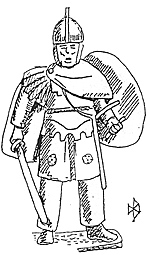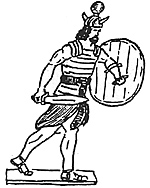 I find that one of the more challenging aspects of solo wargaming is devising systems of manoeuvring on the wargames table. The ultimate challenge, of course, is to find a method of creating an intelligent opposition to my own battle plan that does not involve a great deal of ‘good sense adjusting’ on my part and avoids altogether the occurrence of ridiculous and unrealistic situations - a sort of live opponent of my own devising.
I find that one of the more challenging aspects of solo wargaming is devising systems of manoeuvring on the wargames table. The ultimate challenge, of course, is to find a method of creating an intelligent opposition to my own battle plan that does not involve a great deal of ‘good sense adjusting’ on my part and avoids altogether the occurrence of ridiculous and unrealistic situations - a sort of live opponent of my own devising.
For me this is still an unattained dream, and I suspect it will always remain so. I still find it more satisfactory to take the god-like role of operating both sides as fairly as possible rather than struggling to devise fool-proof ways of giving the enemy an intelligent ‘general’ to scotch my plans and devise plans against me.
Over the years I’ve toyed with many ideas, chopped and changed a bit here and added a bit there, but what most often seems to happen is that it all develops into an almost workable but cumbersome and time-consuming mess.
This article covers a method I have devised for a game in which I play God and control both sides. It does, however, provide an interesting variant on move-counter move and alternate move systems. It is extremely simple to use and virtually non-time consuming, which has to be a bonus.
The rules allow more efficient or lucky commanders to move and conduct combat more regularly than their more cumbersome (or unlucky) enemies or allies, although this is by no means a certainty and even the best of leaders dogged by bad luck can be outmanoeuvred by a less gifted general.
Since the rules also allow outflanking, reinforcing and other opportunities to be exploited or missed they lead to a more exciting game than the strict alternate move game.
The rules work far more satisfactorily with armies that are divided into battles, wings, divisions, brigades etc. rather than a ‘one leader controls all’ type army such as in DBA.
I use the system with both homegrown rules and with DBM, DBR, Armati and Fire and Fury, but see no reason why it should not work with most other game rules.
The system comes in two parts, either of which may be used on its own.
To begin with, I give each leader/general a rating, although this is by no means a must; if you wish to deem all such persons as ‘average’ then do so.
My own rating system ensures that not many tactical geniuses occur and that a fair smattering of slow, stolid or just plain stupid leaders may crop up, but that the majority will most probably be of average and reasonable ability.
The ratings are decided by a d10 dice throw as follows:
| 1d10 | COMMAND | INITIATIVE | RATING |
|---|---|---|---|
| 9 | -1 | 10 | Above average |
| 8,7,6,5,4,3 | 0 | 9 | Average |
| 2,1,0 | +1 | 8 | Poor |
| A command that loses its leader uses the following: | |||
| Leaderless | +2 | 7 | N/A |
For solo play I usually determine the ratings of the leaders after deployment, although obviously in a campaign leaders that take part in several battles will become familiar and carry the same rating throughout.
Having established the leader ratings, which as I have said can be ignored if desired by assuming that all leaders are of average (0, 9) ability, and having deployed for battle, I now determine the order of play for the leaders, which is basically the first opportunity each of them has to spring into action.
The sequence for such events is recorded onto a rota, which is simply a sheet of lined paper with the turn numbers in a column down the left-hand side.
To determine the order of play, roll 1d5 (average die) per leader, each adding or subtracting his personal first command rating (i.e. +1, 0 or -1). For a more random spread use 1d6 instead, but be prepared to have commands taking double or even triple turns.
The modified score equals the turn on the rota in which the leader may initiate an action other than to defend himself, which is automatic when another command is activated against him.
An ‘activation’ includes all movement, shooting and combat. The leader’s means of identification (name, letter, number) is recorded against the appropriate move turn on the rota. All leaders that occupy Game Turn 1 are deemed to be activated and may conduct movement and combat with their commands. If no leader is occupying a turn then proceed to the next turn.
 If two or more leaders occupy the same Game Turn, then they may all activate if they are on the same side. If they are not all on the same side, then decide by die roll which faction steals the initiative and activates its leader(s) first in the turn.
If two or more leaders occupy the same Game Turn, then they may all activate if they are on the same side. If they are not all on the same side, then decide by die roll which faction steals the initiative and activates its leader(s) first in the turn.
As each leader completes a turn, delete his name from the current move, re-roll the d5 and modify it by his command rating. The score determines the number of moves before the leader may activate again.
Thus, as will soon become obvious, a -1 leader is more likely to reactivate sooner than a 0 or +1 rated leader, and this allows for some daring manoeuvring.
If a leader is lost during a turn, then his command immediately reverts to a ‘Leaderless’ rating (+2, 7), and will subsequently add +2 to all d5 activation determining die rolls.
This concludes the method of establishing the turn rota, which may be better explained by the example I give later.
Leaders
Now that we have a system for determining who may activate in each phase, we will go on to consider the actual allowances for and restrictions on the individual leaders once activated. This is where the 10, 9, 8 or leaderless 7 rating comes into play, and for this I must thank George Heath, who kindly sent me a set of fantasy game rules for which he had no further use.
The one really useful idea that came out of the rules, which I developed to suit myself, is their leadership initiative movement. Basically, it works like this. The leaders have a rating (10, 9, 8 etc.) which with the use of two d6 scores influences how much, if any, movement which troops under their command may make. Each time that a unit or group of units moves, the leader’s initiative rating is temporarily reduced by 1; thus a leader rated 9 wishing to move a unit/group must score 9 or less to do so. If he then wishes to continue moving either the same body of troops or another unit/group under his command, then he must score 8 or less to do so, and so on.
The leader may continue to conduct movement with his forces as many times as he wishes or until he rolls a die score total higher than his current modified initiative rating. On subsequent reactivation turns the leader reverts to his original initiative rating and begins again.
To these basic rules I have added the following:
- A unit/group to which the leader is attached may score one higher than his current modified initiative rating. In such cases, however, any other troops under his command that are attempting to move will be required to score a maximum of one less than the commander's current modified initiative rating.
A leader may be attached to a single unit/group under his command at the beginning of his activation. The leader may then add any benefits to the attached unit/group in combat.
A group is not obliged to stay together during a move and may end the move separated, but of course no longer counts as a group and any further movement must be tested for individually. Any group may split and does not need to have a leader attached.
Once a leader joins a unit he must remain with it for the entire turn and will not be allowed to detach himself from it until his next activation turn, and may then do so only if the unit/group to which he is attached is not engaged in close combat.
- A unit that is irregular, or a group that has irregular troops in its formation, is required to score below the leader’s modified initiative rating. This is after any other adjustment (such as if the leader is with a different unit). In such a case the irregular unit is required to score better than one below the leader’s current modified initiative rating. This naturally leads to irregular troops being more difficult to manoeuvre and emphasizes the necessity to have them operating in groups as much as possible, unless of course they have a good or very lucky leader.
- If a leader rolls 12 on his first die roll of any turn, then he not only forfeits any movement in the turn but must also add +1 to his next d5 roll on the rota. This is of course in addition to any other modifiers that may be required.
Perhaps it would be a good point here to stress that a leader may not be able to move his troops due to an initiative failure, but he must still conduct any shooting or combat that is already in place.
- In DBM there are rules for controlling impetuous troops which can play a major part in the outcome of a battle, and if impetuous troops are not carefully handled, then a command can soon split itself into small bodies of troops that are difficult, if not impossible, to reassemble, and thus vulnerable to being attacked in isolation. I like this rule in particular and did not wish to lose the flavour of it from my movement system. To cover this aspect of the rules I decided that impetuous troops would act as per DBM (and of course Armati) but may be held in check by a successful command initiative roll rather than the DBM method of allocating PIPs to hold.
Back to Table of Contents -- Lone Warrior #139
Back to Lone Warrior List of Issues
Back to MagWeb Magazine List
© Copyright 2002 by Solo Wargamers Association.
This article appears in MagWeb (Magazine Web) on the Internet World Wide Web.
Other military history articles and gaming articles are available at http://www.magweb.com
